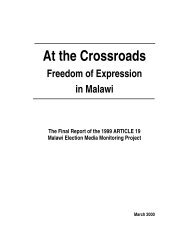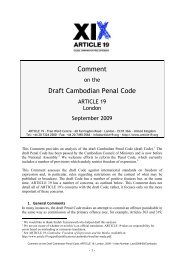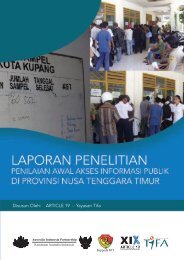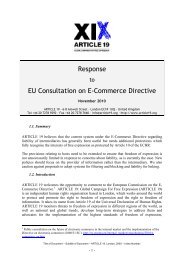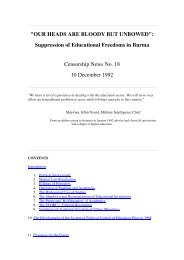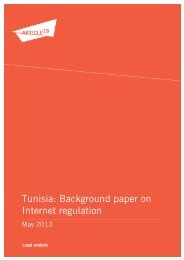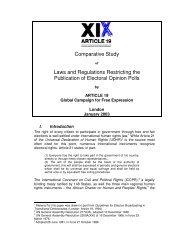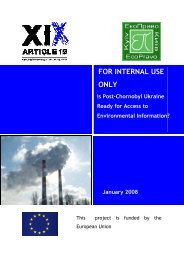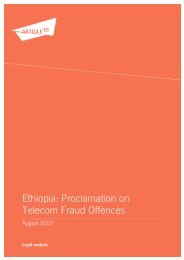Board of Directors European Bank for Reconstruction ... - Article 19
Board of Directors European Bank for Reconstruction ... - Article 19
Board of Directors European Bank for Reconstruction ... - Article 19
You also want an ePaper? Increase the reach of your titles
YUMPU automatically turns print PDFs into web optimized ePapers that Google loves.
<strong>Board</strong> <strong>of</strong> <strong>Directors</strong><strong>European</strong> <strong>Bank</strong> <strong>for</strong> <strong>Reconstruction</strong> and DevelopmentLondon, United Kingdom20 February 2006Dear Executive <strong>Directors</strong>,We are writing regarding the <strong>European</strong> <strong>Bank</strong> <strong>for</strong> <strong>Reconstruction</strong> and Development’s (EBRD)upcoming review <strong>of</strong> its Public In<strong>for</strong>mation Policy (PIP). We understand that the <strong>Board</strong> Financialand Operations Policies Committee (FOPC) will soon be receiving a new draft PIP <strong>for</strong> reviewand, upon their approval, the draft will be released <strong>for</strong> public comment. The GlobalTransparency Initiative (GTI) encourages the EBRD to base its draft PIP on the Right toIn<strong>for</strong>mation, according to which a true presumption <strong>of</strong> disclosure, subject only to a narrowregime <strong>of</strong> exceptions, is established.This letter sets out the GTI’s main priorities in relationship to this recommendation, as well asour specific comments on the proactive disclosure <strong>of</strong> in<strong>for</strong>mation relating to the project cycle andCountry Strategies.The Right to In<strong>for</strong>mationThe right to access in<strong>for</strong>mation held by the IFIs is a fundamental human right which appliesregardless <strong>of</strong> the source <strong>of</strong> the in<strong>for</strong>mation (who produced the document) and whether thein<strong>for</strong>mation relates to a public or private sector actor. There are four main elements in a policybased on the right to in<strong>for</strong>mation, as well as the general obligation to disclose on a proactivebasis, even in the absence <strong>of</strong> a request, the subject <strong>of</strong> the second part <strong>of</strong> this letter. Thesestandards are set out in far greater detail in the GTI IFI Transparency Charter. 1First, and central to the right to in<strong>for</strong>mation, is a genuine presumption <strong>of</strong> disclosure, accordingto which all in<strong>for</strong>mation held by the <strong>Bank</strong> should be subject to disclosure upon request, subjectonly to a regime <strong>of</strong> narrowly-defined exceptions providing justification <strong>for</strong> withholding certainin<strong>for</strong>mation. This list should be explicit, indicating the precise harm that would result fromdisclosure.1 This is available in several languages on the GTI website, http://www.ifitransparency.org.
Global Transparency Initiative 20 February 2006Second, the policy should provide <strong>for</strong> clear procedures by which requests <strong>for</strong> in<strong>for</strong>mation willbe processed. These should include, among other things, clear timelines <strong>for</strong> responding torequests, rules relating to any charges <strong>for</strong> providing in<strong>for</strong>mation and a requirement to providewritten reasons <strong>for</strong> any refusals to provide in<strong>for</strong>mation.Third, the policy should set out a clear, narrow and exclusive list <strong>of</strong> exceptions to the right <strong>of</strong>access. Exceptions should be clear and as narrow as possible, and based on a harm test. Forexample, the exception <strong>for</strong> “business confidentiality” should clearly define the types <strong>of</strong>commercially-sensitive in<strong>for</strong>mation that cannot be disclosed, such as trade secrets or in<strong>for</strong>mationthat would harm the competitive position <strong>of</strong> the party that supplied the in<strong>for</strong>mation. Broadexceptions which do not specify a specific harm, such as in<strong>for</strong>mation relating to the “deliberativeprocess” or “all correspondence”, should be avoided. The current PIP includes some exceptionsthat do not con<strong>for</strong>m to this best practice approach. For example, the PIP exempts “in<strong>for</strong>mationin the <strong>Bank</strong>’s possession which was not created by the <strong>Bank</strong> and is identified by its originator asbeing sensitive and confidential”. This does not require any harm and could cover any and allin<strong>for</strong>mation submitted to the <strong>Bank</strong> by public or private sector project sponsors. All exceptionsshould be reviewed to ensure that they focus on the “harm” that would be caused by disclosure,rather than just exempting particular categories <strong>of</strong> in<strong>for</strong>mation.Exceptions should also be subject to a public interest override so that, where relevant andconsidering all <strong>of</strong> the circumstances, in<strong>for</strong>mation will be released despite a risk <strong>of</strong> harm to alegitimate interest, where this serves the overall public interest. This might be the case, <strong>for</strong>example, where the in<strong>for</strong>mation discloses a severe environmental risk or evidence <strong>of</strong> corruption.A fourth key element <strong>of</strong> the presumption in favor <strong>of</strong> disclosure is a right to appeal against nonapplication<strong>of</strong> the policy, so that anyone who believes that the EBRD has failed to respect thePIP, including through a refusal to provide in<strong>for</strong>mation in response to a request, should have theright to have the matter reviewed by an independent and authoritative body.Provisions <strong>for</strong> appeals and a public interest override are increasingly being recognized by otherInternational Financial Institutions (IFIs). Notably, the Asian Development <strong>Bank</strong> (ADB), in its2005 Public Communications Policy, has established an internal body to review publiccomplaints related to disclosure policy implementation. While lacking the independencecommonly found in appeals bodies which deal with national in<strong>for</strong>mation disclosure laws, theADB’s process at least includes clear timelines regarding responses to appeals, an obligation toexplain the decision taken, and the public disclosure <strong>of</strong> these appeals, including the nature <strong>of</strong> anddecision on the appeal.The IFC is also considering an internal appeals provision in its draft disclosure policy, currentlyunder review. The IFC has built into its draft policy an “exceptional circumstances” provisionthat allows <strong>for</strong> a public interest override when disclosure <strong>of</strong> normally confidential in<strong>for</strong>mation“would be likely to avert imminent and serious harm to the public health or safety, and/orimminent and significant adverse impacts on the environment.” 22 IFC Draft Policy on Disclosure <strong>of</strong> In<strong>for</strong>mation, September 2005, p. 4.2
Global Transparency Initiative 20 February 2006At a minimum, the EBRD should incorporate an appeals process and public interest overrideprovision similar to those at the ADB and IFC in its new draft PIP.Routine DisclosureWhile in<strong>for</strong>mation should be available upon request according to a presumption in favor <strong>of</strong>disclosure as described above, certain important in<strong>for</strong>mation which is regularly produced andcommonly requested should also be proactively disclosed, via the <strong>Bank</strong>’s local <strong>of</strong>fices and itswebsite.Such disclosure should include a wide range <strong>of</strong> in<strong>for</strong>mation about EBRD structure, policies andprocedures, decision-making processes, and country and project work. This in<strong>for</strong>mation shouldbe made available in a timely fashion and in a language and via a medium that ensures thatinterested stakeholders can effectively access it.An important aspect <strong>of</strong> routine disclosure is timely disclosure, in which in<strong>for</strong>mation held by the<strong>Bank</strong> or project sponsor is made available to stakeholders within a specified framework. Anytimeline should be designed to ensure that the in<strong>for</strong>mation is released in time to be <strong>of</strong> use, <strong>for</strong>example, be<strong>for</strong>e final decisions on a project, policy or strategy are made, such that stakeholderscan engage with <strong>Bank</strong>-financed operations throughout the project cycle and Country Strategies inan effective and in<strong>for</strong>med fashion.1. Project In<strong>for</strong>mationAccess to EBRD documents produced during the project cycle remains limited. While thecurrent PIP requires the disclosure <strong>of</strong> Project Summary Documents and Environmental Annexes<strong>for</strong> both public and private sector operations, the majority <strong>of</strong> project-specific in<strong>for</strong>mationremains confidential.In an ef<strong>for</strong>t to disclose in<strong>for</strong>mation routinely, the EBRD should make the revisions describedbelow to the PIP to address the lack <strong>of</strong> transparency surrounding all phases <strong>of</strong> the project cycle.While the disclosure <strong>of</strong> relevant environmental and social documents is covered under the scope<strong>of</strong> the <strong>Bank</strong>’s Environmental Policy, the PIP should be revised to include theserecommendations, rein<strong>for</strong>cing a true presumption in favor <strong>of</strong> disclosure and making the PIP acomprehensive guide to disclosure within the EBRD.In order to provide routine access to in<strong>for</strong>mation, the EBRD should establish an Internetbasedmechanism <strong>for</strong> tracking project status and project-related in<strong>for</strong>mation, similar to that<strong>of</strong> the World <strong>Bank</strong>. The mechanism would bring together relevant project in<strong>for</strong>mation anddocuments in all phases <strong>of</strong> the lending cycle and make these documents readily available throughan updated and searchable database.To effectively engage with EBRD-financed projects, citizens need to have access toenvironmental and social documents under consideration during the project’s early appraisalphase. The EBRD should publicly disclose initial discussion papers at the time suchdocuments are produced, including the Concept Clearance Memorandum, Concept Review3
Global Transparency Initiative 20 February 2006Memorandum, Initial Environmental Examinations, Final Review Memorandum, and duediligence requirements <strong>for</strong> Financial Intermediaries. While some <strong>of</strong> this in<strong>for</strong>mation is disclosedin Environmental Summaries (ES) attached to Project Summary Documents (PSDs), thisin<strong>for</strong>mation is neither disclosed in its entirety nor in a timely fashion <strong>for</strong> effective publicinvolvement. The EBRD should also require the project sponsor to release environmental andsocial documents they hold, at the time such documents are produced. This includes, but is notlimited to environmental and social documents that project sponsors and consultants generate atthe request <strong>of</strong> EBRD pursuant to the <strong>Bank</strong>’s due diligence process.Although we welcome the disclosure <strong>of</strong> PSDs <strong>for</strong> public sector projects “as soon as possible afterthe project has passed its Initial Review by <strong>Bank</strong> management,” 3 private sector PSDs aredisclosed only 30 days prior to <strong>Board</strong> consideration. In line with timely, routine disclosure, the<strong>Bank</strong> should disclose public and private sector PSDs immediately after Initial Review andnot less than 60 days prior to <strong>Board</strong> review.We recommend that EBRD take a more proactive role in initiating a genuine presumption infavor <strong>of</strong> disclosure upon project approval. The EBRD should disclose all documents relatedto the loan agreements between the EBRD and the project sponsor, including theEnvironmental Action Plan and loan contract.Once a project is approved, the EBRD should routinely and publicly disclose allimplementation and supervision documents produced by the <strong>Bank</strong> or project sponsor.Public disclosure <strong>of</strong> these documents allows affected communities to hold both the EBRD andprivate and public sector actors accountable <strong>for</strong> commitments made during project design. TheEBRD should, where applicable, release project monitoring reports, including annualenvironmental reports, environmental consultants’ reports, periodic environmental audits,environmental per<strong>for</strong>mance ratings, exit audits and site-visit reports. The EBRD should alsorequire project sponsors to disclose these reports to locally affected people. The ADB hasalready implemented such a rule- the disclosure <strong>of</strong> social and environmental monitoring reports<strong>for</strong> public and private sector projects- in its Public Communications Policy. 4The public should have access to in<strong>for</strong>mation documenting any unexpected impacts on the healthand safety <strong>of</strong> local communities and ecosystems associated with the project. There<strong>for</strong>e, accidentreports should become publicly available upon their submission to the <strong>Bank</strong>.In order to engage as an equal partner in lessons learned from <strong>Bank</strong>-financed developmentprojects, the public should also have access to EBRD project evaluations and assessments. The<strong>Bank</strong> should disclose full reports <strong>of</strong> the Project Evaluations Department, includingOperation and Per<strong>for</strong>mance Evaluation Reports, at the time <strong>of</strong> their submission to the<strong>Board</strong> <strong>for</strong> approval.3 EBRD Public In<strong>for</strong>mation Policy, July 2003, p. 8.4 ADB Public Communications Policy 2005, Paragraph 92.4
Global Transparency Initiative 20 February 20062. Country StrategiesWe welcome EBRD’s ef<strong>for</strong>ts to consult with stakeholders in the early phases <strong>of</strong> CountryStrategy preparation and to provide translations into local languages, on a pilot basis, <strong>of</strong>approved strategies.However, while the current PIP solicits public comments based on existing Country Strategiesand an accompanying management note that outlines “the main areas to be focused upon in theReview,” the PIP does not require the disclosure <strong>of</strong> draft Country Strategies or EBRDevaluations <strong>of</strong> previous Country Strategies on which the public is consulted. Furthermore,current PIP requirements regarding public consultation practices require neither the disclosure <strong>of</strong>draft Country Strategies in relevant local languages nor notification <strong>of</strong> the public aboutupcoming consultations.The disclosure <strong>of</strong> draft Country Strategies and institutional evaluations <strong>of</strong> previous countrystrategies is becoming a minimum transparency requirement at other institutions. In the last twoyears, both the ADB and the African Development <strong>Bank</strong> have adopted policies requiring thedisclosure <strong>of</strong> draft country strategies prior to <strong>for</strong>mal management and <strong>Board</strong> discussions on thesestrategies, which include time-bound consultation procedures. Further, both the ADB and theWorld <strong>Bank</strong> now disclose institutional evaluations <strong>of</strong> previous country strategies prior toreviewing a strategy. To remain on par with these regional development banks and establish the<strong>Bank</strong> as a leader in transparency standards, the EBRD should publicly disclose:• Draft Country Strategies in relevant local and national languages prior to initiating aCountry Strategy Review.• Specific timelines and procedures regarding the extent and nature <strong>of</strong> the publicconsultations regarding Country Strategy reviews, including post and email notifications,in relevant local languages, <strong>of</strong> upcoming consultations. While the EBRD follows theseprocedures <strong>for</strong> some countries, the <strong>Bank</strong> should require these procedures <strong>for</strong> all countries.• All public comments received during consultations in their original <strong>for</strong>m, andmanagement responses to such comments, at the time <strong>of</strong> submission to the ExecutiveCommittee and <strong>Directors</strong>. If management does not incorporate public comments into theFinal draft Country Strategy, an explanation <strong>for</strong> this should be made public. As the <strong>Bank</strong>has begun doing this in some instances, this recommendation should be incorporated aspolicy in the revised PIP.• Final draft Country Strategies at the same time that they are distributed to the <strong>Board</strong> <strong>of</strong><strong>Directors</strong> <strong>for</strong> consideration.• <strong>Board</strong> deliberations regarding the final draft Country Strategies.• Action plans <strong>for</strong> Country Strategy implementation. These should be disclosed uponapproval <strong>of</strong> Country Strategies and <strong>of</strong>fered <strong>for</strong> public consultation.Further, we recommend that the EBRD adopt a more systematic approach to elaborating andpublishing Country Strategy Evaluations. The Country Strategy Evaluations should be carriedout on regular basis and disclosed after <strong>Board</strong> approval.5
Global Transparency Initiative 20 February 2006We appreciate your attention and look <strong>for</strong>ward to incorporation <strong>of</strong> our suggestions into therevised draft PIP. We also welcome the opportunity to comment more extensively when the draftis released.Any questions, comments, or responses may be directed to Jennifer Kalafut(jkalafut@bicusa.org) or David H<strong>of</strong>fman (dh<strong>of</strong>fman@bicusa.org) at <strong>Bank</strong> In<strong>for</strong>mation Center.Sincerely,Global Transparency Initiative Steering Committee:Access to In<strong>for</strong>mation Network (ATIN), PhilippinesARTICLE <strong>19</strong>, United Kingdom<strong>Bank</strong> In<strong>for</strong>mation Center, United StatesBretton Woods Project, United KingdomCEE <strong>Bank</strong>watch Network, Czech Republicfreedominfo.org, United StatesInstitute <strong>for</strong> Democracy in South Africa (IDASA), South AfricaLibertad de In<strong>for</strong>mación-México AC (LIMAC), MexicoCc:Mr. Jean Lemierre, President, EBRDMr. Paul Martin, Principle Advisor and Financial and Operations Policies Committee (FOPC)Secretary, EBRDMr. Horst Reichenbach, Secretary General, EBRDThe Global Transparency Initiative (GTI) is a network <strong>of</strong> civil society organisations promotingopenness in the International Financial Institutions (IFIs), such as the World <strong>Bank</strong>, the IMF, the<strong>European</strong> Investment <strong>Bank</strong> and Regional Development <strong>Bank</strong>s. The GTI brings together twocommunities <strong>of</strong> activists and experts from around the world - one, those groups campaigning <strong>for</strong>full accountability in the use <strong>of</strong> public power vested in the IFIs; the other, groups that have beencampaigning <strong>for</strong> the right to access to in<strong>for</strong>mation at the nation-state level.For more in<strong>for</strong>mation about the GTI, go to: www.ifitransparency.org.6



